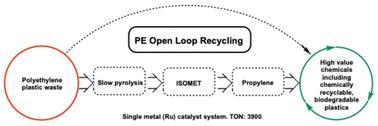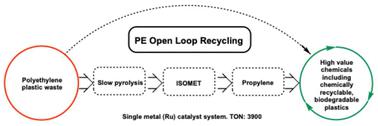钌催化的串联异构化-甲基化聚乙烯 "开环 "循环(ISOMET)
IF 9.2
1区 化学
Q1 CHEMISTRY, MULTIDISCIPLINARY
引用次数: 0
摘要
作为化学升级再循环工艺的典范,我们开发了一种单金属均相催化系统,可将持久性聚乙烯废料分解为有价值的化学中间体。这最终可用于生产重要的化学产品,包括环保型生物降解塑料。第一步,对聚烯烃废料进行缓慢热解,产生油类,主要成分是长链烯烃。然后,在下一个转化步骤中,将定制的双环(烷基)(氨基)碳烯(BICAAC)-Ru 烯烃偏聚催化剂与烯烃异构化催化剂(RuHCl(CO)(PPh3)3)结合使用,在乙烯气氛中通过异构化-偏聚(ISOMET)反应将热解油转化为丙烯。最终,高效单金属催化剂系统将 ISOMET 反应转化为 900 mL 反应器装置,重复批量实验证明了催化剂系统的长期稳定性,以及迄今为止所报道的使用消费后聚乙烯废料原料的最高总周转次数(tTON = 2788 摩尔丙烯/摩尔烯烃偏聚催化剂)。本文章由计算机程序翻译,如有差异,请以英文原文为准。


Ruthenium-catalyzed “open-loop” recycling of polyethylene via tandem isomerization-metathesis (ISOMET)†
As a model of a chemical upcycling process, we have developed a single-metal homogeneous catalytic system to break down persistent polyethylene waste into valuable chemical intermediates. This could ultimately be used to produce important chemical products, including environmentally friendly, biodegradable plastics. In the first step, a slow pyrolysis of polyolefin waste yields oils, containing long-chain olefins as the major components. Then, for the next transformation step, tailored bicyclic (alkyl)(amino)carbene (BICAAC)-Ru olefin metathesis catalysts were used in combination with an alkene isomerization catalyst (RuHCl(CO)(PPh3)3) for the transformation of the pyrolysis oil to propylene via isomerization-metathesis (ISOMET) reaction in ethylene atmosphere. Eventually, translation of the highly efficient single-metal catalyst system enabled ISOMET reaction to a 900 mL reactor setup and repetitive batch experiments could prove the long-term stability of the catalyst system and the highest total turnover number (tTON = 2788 mol propylene per mol olefin metathesis catalyst) reported so far using post-consumer polyethylene waste feedstock.
求助全文
通过发布文献求助,成功后即可免费获取论文全文。
去求助
来源期刊

Green Chemistry
化学-化学综合
CiteScore
16.10
自引率
7.10%
发文量
677
审稿时长
1.4 months
期刊介绍:
Green Chemistry is a journal that provides a unique forum for the publication of innovative research on the development of alternative green and sustainable technologies. The scope of Green Chemistry is based on the definition proposed by Anastas and Warner (Green Chemistry: Theory and Practice, P T Anastas and J C Warner, Oxford University Press, Oxford, 1998), which defines green chemistry as the utilisation of a set of principles that reduces or eliminates the use or generation of hazardous substances in the design, manufacture and application of chemical products. Green Chemistry aims to reduce the environmental impact of the chemical enterprise by developing a technology base that is inherently non-toxic to living things and the environment. The journal welcomes submissions on all aspects of research relating to this endeavor and publishes original and significant cutting-edge research that is likely to be of wide general appeal. For a work to be published, it must present a significant advance in green chemistry, including a comparison with existing methods and a demonstration of advantages over those methods.
 求助内容:
求助内容: 应助结果提醒方式:
应助结果提醒方式:


